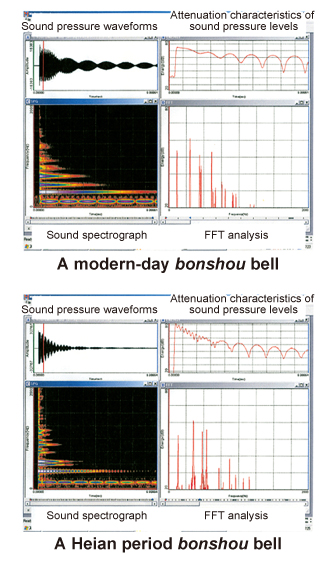The Quest for an Ideal Bonshou Bell Tone – a Sound Not Even Cutting-Edge Technologies Can Replicate
After a Bonshou bell mold is complete, copper and tin are melted in a crucible, and the molten metal is poured into the mold. Once the metal has hardened, the mold is broken away and the bell removed. All the steps of the Bonshou bell casting process up to this point are performed by hand by seasoned craftsmen, as they have been for many generations. However, in the days when the plans for the original Ohjikicho bell were drafted, craftsmen had no technologies to help them record and analyze the sound of bells, or to aid them in sound replication. This is where the challenge of the Iwasawa Bell Company began. First, they placed microphones around existing Bonshou bells, gathering samples of the sound these bells produce. Next, plans for sound analysis were drafted, and the company continued to research ways of creating a bell mold that would improve the sound, rather than the shape, of a Bonshou bell, focusing on such things as the thickness of the bell walls, materials that would help them achieve a more “ideal” sound, and the pouring temperature of the metal during the casting process.
Computer analysis was eventually introduced into this process, and it was discovered that the Bonshou bell sounds recorded by IC recorders fell into the categories of atari, okuri, and oshi, the three essential elements of a bell tone. The atari, or “attack,” was the sound produced when a Bonshou bell was struck by a suspended wooden log, and lasted for 2-3 seconds. Following this was the okuri, or “sustain,” and finally came the oshi, or “decay,” referring to the lingering reverberations of the bell tone. These three patterns were input into a computer for comparison, and an oscilloscope was used to make detailed measurements of the oscillatory waveforms. Recently, analysis of the sound data has also been carried out using the FFT (Fast Fourier Transform) methods. However, these methods in themselves were not enough to perform a complete sound analysis. The perception of sound is something that can be affected by the age or physical condition of the listener, or even by such factors as humidity or wind direction. In the profound and complicated world of sound, the challenges never end.

